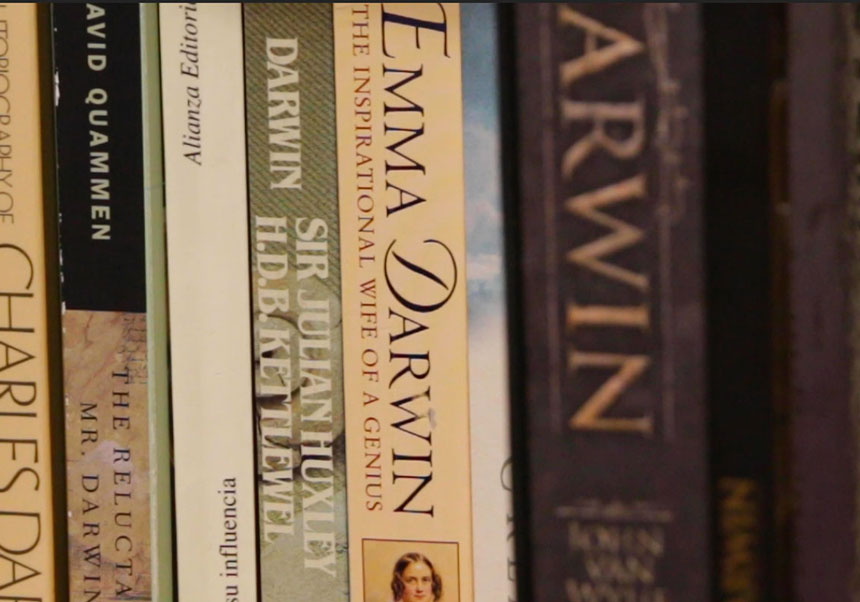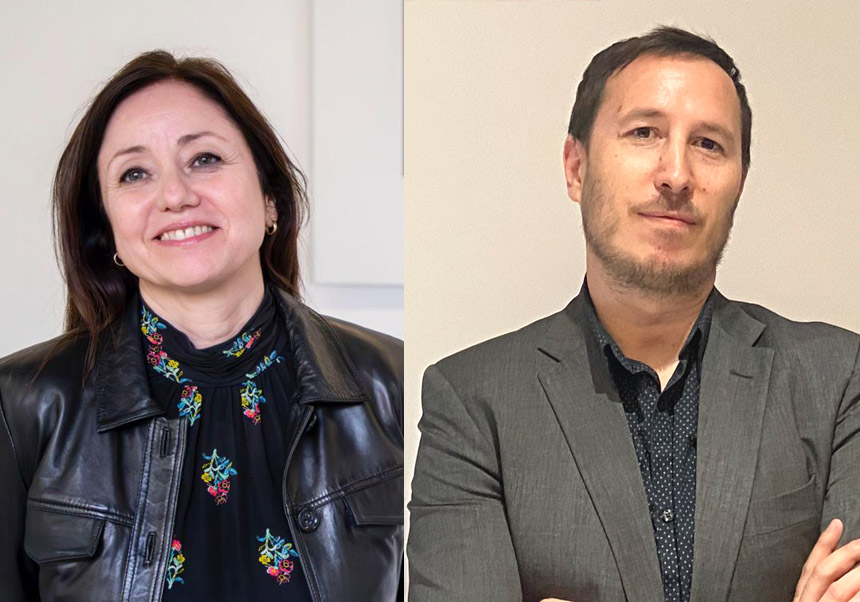An astronomer of the Universitat de València participates in the shot of the first image of a black hole
- Press Office
- April 11st, 2019
The Universitat de València has taken part in an international project that entails a change in the paradigm of the observations of a supermassive black hole situated in the centre of the Messier 87 galaxy. Rebecca Azulay, from the Universitat de València, has participated in the research.
The Event Horizon Telescope (EHT), a global scale telescope consisting of eight radio telescopes and built through international collaboration, was designed with the purpose of capturing the first images of black holes. In a series of simultaneous international press conferences that took place on the 10th of April all around the world, researchers of the EHT have revealed they have finally been successful and they have shown the first direct visual evidence of a supermassive black hole and its shadow.
This scientific milestone has been announced in a series of six scientific articles published in a special edition of the journal Astrophysical Journal Letters. The image shows the black hole in the centre of Messier 87 (M87) (1), a massive galaxy situated in the near cluster of galaxies called the Virgo Cluster. This black hole is 55 million light years away from the Earth and is 6.5 billion times the mass of the Sun (2).
The EHT connects the signals of the radio telescopes, distributed all around the planet, in order to form a virtual telescope with the size of the Earth that has an unprecedented sensibility and resolution (3). The EHT is the result of many years of international collaboration and offers the scientists a new way to study the most extreme objects of the Universe predicted by Einstein’s general relativity, a century after the historical experiment that confirmed this theory for the first time (4).
‘We have captured the first image of a black hole’ said the director of the EHT, Sheperd S. Doeleman, from the Center for Astrophysics Harvard & Smithsonian (United States). ‘This is a scientific milestone in astronomy achieved by a team of more than 200 researchers’, he added.
Black holes are extraordinary cosmic objects that have a huge mass but are extremely compact. The presence of these objects affects their environment extremely, curving spacetime and overheating any adjoining material.
‘When immersed in a bright region, like a disk of glowing gas, we expect a hole to generate a dark region that’s similar to a shadow, something that was already predicted by Einstein’s general relativity but we had never been able to see until now’, explained the Chair of the Science Council of the EHT, Heino Falcke, from Radboud University (Netherlands). ‘This shadow, caused by the gravitational field and the absorption of light by the event horizon, reveals so much about the nature of these fascinating objects and has also allowed us to measure the colossal mass of the M87 black hole’ he explained.
Several independent observations of the EHT, each of them analysed with different methods of image reconstruction, have revealed a ring-shaped structure with a dark region in the centre: the shadow of the black hole.
‘Once we were sure we had captured the shadow, we were able to compare our observations with a wide range of computer simulations that include the physics of the curved space, the overheated matter and powerful magnetic fields around the black hole. Many of these characteristics of the observed image surprisingly coincide with our theoretical predictions’, ‘this confirms our theoretical interpretation of the observations, including the estimation of the mass of the black hole’.
The creation of the EHT has entailed a fantastic landmark that was achieved through the modernisation and connection of a world network of eight already existing telescopes located in remote areas of great altitude. These locations include volcanos in Hawaii (United States) and Mexico, mountains in Arizona (United States) and Sierra Nevada (Spain), the Chilean dessert and the Antarctica.
The observations of the EHT use a technique denominated Very-long-baseline interferometry (VLBI), which synchronises telescopes all around the world and uses the rotation of the Earth to use a gigantic virtual telescope that’s the size of our planet. Observing a wavelength of 1.3 millimetres and thanks to the VLBI technique, the EHT is able to reach an angular resolution of only 20 microarcseconds, enough to read a newspaper in New York from a coffee shop in Paris (6).
The telescopes used for obtaining these results are: Atacama Large Millimeter/submillimeter Array (ALMA), Atacama Pathfinder EXperiment (APEX), both in Chile; the IRAM 30 meter telescope in Sierra Nevada (Spain); the James Clerk Maxwell Telescope, in Hawaii (USA); the Gran Telescopio Milimétrico Alfonso Serrano (Mexico), the Submillimeter Array (Hawaii), the Submillimeter Telescope, in Arizona (USA), and the South Pole Telescope, in the Antarctica (7).
The launch of the EHT and the observations announced today entail the culmination of decades of observational, technical and theoretical work. This example of global team work has required the close collaboration of researchers all around the world. Thirteen associated institutions have worked in the creation of the EHT, using already existing facilities and extra financial support obtained from a wide variety of agencies, among which we can find the US National Science Foundation (NSF), the European Research Council (ERC) and financial agencies in Asia.
Valencian astronomers
Several Valencian astronomers have taken part in this scientific milestone. On the one hand, Rebecca Azulay, post-doctoral researcher supported by the Generalitat Valenciana (Valencian Government) through the APOSTD call, who is currently working in the Astronomy and Astrophysics Department and the Observatorio Astronómico of the Universitat de València. She has participated in the observations of the the IRAM 30 meter telescope located in Sierra Nevada (Granada). Azulay was also a part of the team that was in charge of configuring the technical equipment of the aerial.
On the other hand, Iván Martí-Vidal, from the Instituto Geográfico Nacional (IGN), designed the algorithms that allowed to combine the data of ALMA (the most sensible element of the EHT) with the rest of the telescopes. He is also the coordinator of the polarimetry group (the main purpose of which is to study the role of the magnetic fields in the proximities of the black hole). Martí-Vidal is also the main researcher of the project ‘Generació Talent’ (GenT) of research excellence, financed by the Generalitat Valenciana, that will start in June 2019 in the Observatorio Astronómico of the Universitat de València.
‘We have used state-of-the-art instrumentation in the IRAM 30 meter telescope. This way, we have been able to record a huge amount of data that have been crucial for the reconstruction of the shadow of the M87 black hole’, explained Azulay.
‘This isn’t only the first image of a black hole, it’s also a first frame; the first frame of a big film still to be shot’, claims Martí-Vidal. ‘The EHT will continue to observe this hole, as well as other black holes. Little by little, we will observe and learn about how matter behaves in these extreme regions of existence’ says the astronomer.
‘We have achieved something that simply seemed impossible only a generation ago’ concluded Doeleman. ‘The technological advances, the connection between the best radio telescopes in the world and the development of new algorithms have allowed us to open a completely new window for studying these black holes and the event horizon.’
Notes
[1] The shadow of a black hole is the closest we can get to obtain an image of the black hole itself, a completely dark object from which not even light is able to escape. The edge of the black hole -the event horizon from which the EHT has taken the name- is 2.5 times smaller than the shadow it casts and has a size a bit smaller than 40 billion kilometres.
[2] Black holes are relatively small objects, something that made them almost impossible to observe until now. Since the size of a black hole is proportional to its mass, the more massive the black hole, the bigger its shadow. Thanks to its gigantic mass and relative proximity, the Messier 87 (M87) black hole is estimated to be one of the biggest holes that can be observed from Earth, something that makes it the best target for the EHT.
[3] Although the telescopes are not physically connected, it is possible to synchronise the recorded signal using atomic clocks (hydrogen maser) which, accurately, label the data obtained with a temporal mark. These observations were made from a wavelength of 1.3 millimetres during the observational campaign of the EHT in 2017. Each EHT telescope produces a high amount of data -around 350 terabytes every day- recorded in high performance hard disks filled with helium. The data are then sent to specialised supercomputers at the Max Planck Institute for Radio Astronomy and MIT Haystack Observatory, which combines them to finally obtain an image.
[4] 100 years ago, two expeditions departed from the Principe island, in front of the African coast, and Sobra, in Brazil, to observe the lunar eclipse of 1919. The purpose was to test the general relativity for the first time by measuring if the light in the stars got deviated when they passed next to the surroundings of the sun, just like Einstein had predicted. Emulating these observations, members of the EHT team have visited some of these remote radio astronomic facilities in order to test once more our understanding of the gravity.
[5] East Asian Observatory (EAO) is an associate of the EHT that represents the participation of several Asian regions, including China, Japan, Korea, Taiwan, Vietnam, Thailand, Malaysia, India and Indonesia.
[6] Future observations of the EHT will entail a significant increase of sensibility thanks to the participation of IRAM NOEMA Observatory, Greenland Telescope and Kitt Peak Telescope.
[7] ALMA is a consortium formed by the European Southern Observatory (ESO; Europe, represented by the member states), the U. S. National Science Foundation (NSF), and the National Institutes of Natural Science (NINS) of Japan, next to the National Research Council (Canada), the Ministry of Science and Technology (MOST; Taiwan), Academia Sinica Institute of Astronomy and Astrophysics (ASIAA; Taiwan), and Korea Astronomy and Space Science Institute (KASI; Republic of Korea), in cooperation with the Republic of Chile. APEX is operated by ESO, the IRAM 30 meter telescope is operated by IRAM (associate organisations of IRAM are MPG, from Germany; CNRS from France; and the IGN, Spain), the James Clerk Maxwell Telescope is operated by the EAO, the Gran Telescopio Milimétrico Alfonso Serrano is operated by the INAOE and, the Submillimeter Array is operated by SAO and ASIAA and the Submillimeter Telescope is operated by the Arizona Radio Observatory (ARO). The South Pole Telescope is operated by the University of Chicago with specialised instrumentation provided by the University of Arizona.
File in: Astronomía i Astrofísica
















